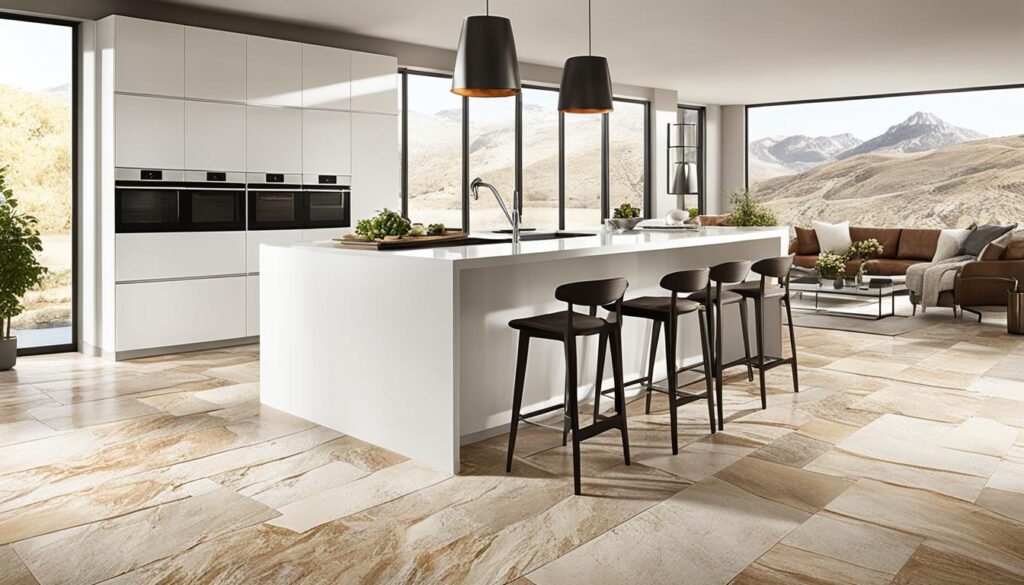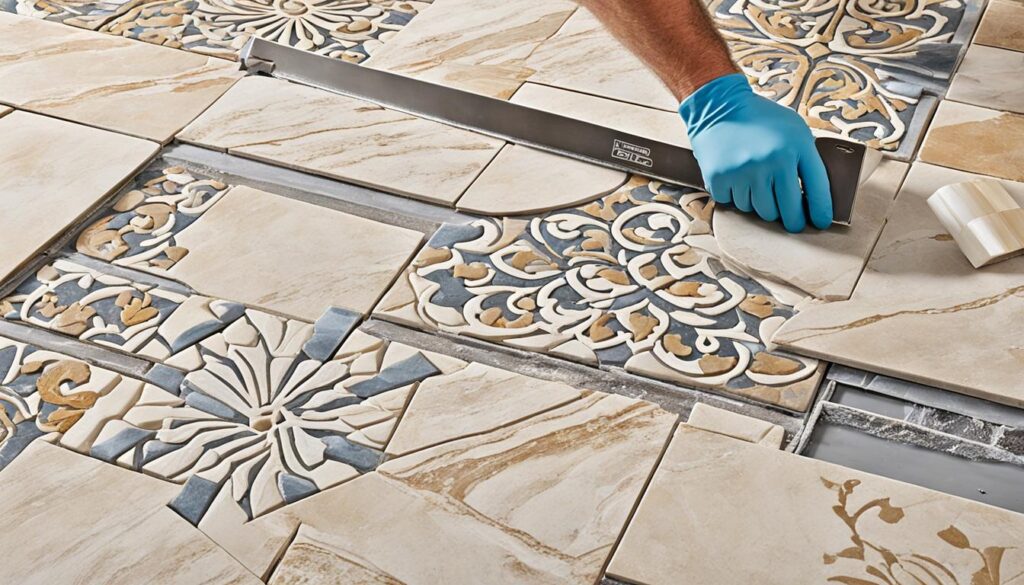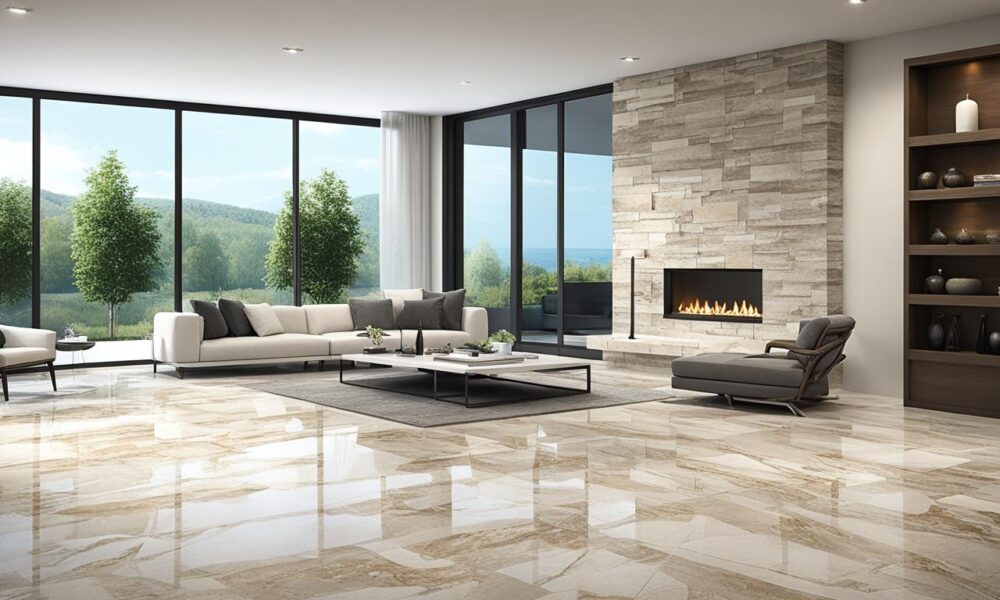Tiling With Natural Stone: Elevate Your Home’s Beauty
Natural stone tiles can make any home look stunning. They mix elegance and toughness in a way that never goes out of style. By adding these tiles to your decor, you can create a space that stands out.1 Slate, granite, marble, travertine, and limestone are common types1. Each one is special, with its own look and feel. This means your floor or wall will be one-of-a-kind1. These stones come in different colors, textures, and designs. Homeowners can use them to build spaces that truly reflect their style2.
For flooring, natural stone is a top choice because it’s so durable. With the right care, these tiles can look great for your whole life.1 This durability makes them perfect for places that get a lot of use, like the kitchen or bathroom. You can make many different looks with stone, from classic to modern.2 No matter if it’s for a bathroom or a kitchen, there’s a natural stone perfect for your project.12
Key Takeaways
- Natural stone tiles offer a blend of elegance, durability, and timeless appeal
- Each natural stone tile is unique, providing a one-of-a-kind look
- Different stone types bring distinctive colors, textures, and patterns
- Natural stone flooring can last a lifetime with proper maintenance
- Stone tiling patterns and techniques can create various design styles
The Timeless Appeal of Natural Stone Tiles
Natural stone tiles are a top pick for many. They are loved because of their beauty, strength, and the way they can be used in many ways. For example, you can find them on floors, walls, countertops, and as design touches3. They keep looking good over time, indoors and out. This is why people who want a classic and sturdy choice go for them4.
Versatility and Durability of Natural Stone
One big win for natural stone tiles is how long they last. With the right care, they stay beautiful for years. This makes them a great choice, especially where lots of people walk3. Stone like granite is super tough, doesn’t mind the heat, and comes in many colors. It’s perfect for busy spots like kitchens and hallways4.
Natural stone tiles fit with many looks, from modern to classic. They bring nature inside, making spaces feel special. Each type of stone offers its own style. For instance, there’s the natural look of travertine, the richness of marble, the friendly warmth of limestone, and the cool surface of slate4.
Unique Blend of Elegance and Functionality
Adding natural stone tiles makes any area feel more elegant. Take marble, for instance. It looks luxurious and comes in unique patterns and colors. This adds a special touch to homes and shops4. Limestone, on the other hand, brings its own charm. Its varied tones and organic feel add a unique vibe to spaces4.
Besides looking good, natural stone tiles are good for you. They don’t cause allergies and don’t let mold or bacteria grow. So your home is healthier3. Plus, stone handles heat well, which is good for cooking and adding warmth to rooms. And, when it’s sourced carefully, using stone is good for the planet3.
| Natural Stone Tile Type | Characteristics | Ideal Applications |
|---|---|---|
| Travertine | Rustic and earthy appearance, porous surfaces, colors like beige, tan, and cream | Enhancing spaces with an organic aesthetic |
| Marble | Luxurious appearance, unique veining patterns, colors like white, rose, black, and green | Adding sophistication to high-end homes and commercial spaces |
| Granite | Exceptional durability, heat resistance, varied hues like gray, red, black, and blue | High-traffic areas like kitchens and hallways |
| Limestone | Warm earthy tones, light beige to warm brown hues, soft yet rugged texture, fossils embedded in some tiles | Adding character and depth to surfaces |
| Slate | Distinct matte finish, rich earthen colors like copper, gray-green, and dark red | Providing slip-resistance for indoor flooring and outdoor spaces |
Choosing the Right Natural Stone for Each Space
When picking natural stone tiles for your home, it’s key to think about the room’s special features. See how these features match with the different stone types. This way, your space will look great and feel right for you.

Considering Room Function and Aesthetic Preferences
Each room has a use, and the stone you choose should fit that need. For busy places like kitchens and mudrooms, pick tough, scratch-proof stones like granite or slate. They’re also great for outside areas like patios5.
Rooms that need a fancy touch, like bathrooms, can use softer stones such as marble. They add a luxury feel. Limestone is also good for elegant areas or as part of the kitchen design5.
What you love to look at matters too. You might like slate’s deep shades, or the gentle beauty of onyx. Think about how the stone’s color and style will fit the room’s existing look. This helps your space feel and look complete5.
Matching Stone Characteristics to Specific Areas
Knowing about the different natural stones helps pair them with the right areas of your home. Below is a table that tells you about each stone and where they’re best used. This info can help you pick the perfect stone for every space:
| Stone Type | Characteristics | Recommended Applications |
|---|---|---|
| Granite | Hardest architectural stone, resistant to scratches, stains, and heat56 | Countertops, high-traffic areas, exterior applications53 |
| Marble | Softer stone, prone to scratches and etching, requires regular sealing56 | Pastry surfaces, backsplashes, tabletops, bathroom floors and walls53 |
| Travertine | Warm earth tones, moderate water resistance, requires regular sealing56 | Interior flooring, countertops, bathroom applications53 |
| Limestone | Softer stone, uniform appearance, porous, requires proper sealing56 | Interior and exterior flooring, walls, backsplashes, fireplace surrounds, pool tiling53 |
| Slate | Rich dark colors, highly durable, slip-resistant, easy to maintain56 | Exterior patios, cladding, indoor flooring in mudrooms and kitchens, bathroom applications563 |
Considering the use and look of your rooms alongside the potential of different natural stones is crucial. It helps you choose the perfect stone. A selection like elegant marble for a bathroom or lasting slate for a patio can really add beauty and charm3.
Tiling With Natural Stone: Creative Design Ideas
Tiling with natural stone gives homeowners many design options. These tiles bring lasting beauty and strength to your home7. By mixing different stones and using them in unique ways, you’ll make a space that stands out.
Mixing and Matching Different Types of Stone
Mixing different stones can make your design really interesting. For instance, using travertine and slate together creates a look that’s both deep and fascinating7. You might choose to mix wood-look tiles with marble. This will give your home a blend of modern style and natural warmth7.
Embracing the Beauty of Natural Variation
No two natural stone tiles are exactly alike, making each one unique8. The differing colors, lines, and finishes add real character to your design. This uniqueness can make any room special, from floors to bathrooms8.
Using Stone Tiles as Accent Pieces
Don’t just use stone tiles on the floor or the walls. They can also be perfect as accents. Features like fireplaces or window frames become special7. For a modern look, try mixing stone and glass in your kitchen or bathroom7.
When choosing stone tiles, think about different patterns. Herringbone, chevron, and basketweave are great for adding flair9. You can find porcelain tiles that look like many types of stone. They come in different finishes too. These options let you create a space that shows off your style8.
Considerations for Natural Stone Tile Installation
Thinking about putting in natural stone tiles at home? Make sure to think about some important stuff. The size and shape of the tiles matter a lot. They affect how the space looks and feels10. Big tiles can make a room seem larger. Small tiles can make it more detailed.

Try different tile sizes to find what works best for your area. And remember, the cost of tiling is around $2,000 for one project10. The price changes based on the stone you choose. Common options include limestone, sandstone, and marble10. Plan to buy 10%-15% more than you need for cuts and mistakes11.
Importance of Professional Installation
Getting your tiles laid by a pro is key for a great finish. There are many steps to follow for the best outcome10. The surface must be clean, flat, and solid11. Use a specific kind of glue for these tiles. It should be 3 to 20 mm thick under the tiles12.
Pros make sure everything is set correctly. Your tiles and spacers need at least 24 hours to settle10. It’s also wise to seal your tiles before grouting to avoid spots10. Mapei fine joint grout works well in busy places like malls12. You might need caulk where it’s always wet, like around tubs10.
Tile Characteristics and Placement
Each stone type is different. For example, marble is great in bathrooms because of its patterns11. Granite is good for areas with lots of people, like hallways. It doesn’t need as much sealing as marble11. Travertine, however, needs more care in busy places. It has holes that might need refilling over time11. Slate can be used inside or out. It just needs a good seal. Limestone wears and tears more but can handle being sealed often11.
| Stone Type | Characteristics | Recommended Areas |
|---|---|---|
| Marble | Veining, unique patterns | Bathrooms, lighter traffic areas |
| Granite | Less porous, requires less sealing | Hallways, kitchens |
| Travertine | Natural voids, requires maintenance | High traffic areas (with maintenance) |
| Slate | Dense, durable, requires sealing | Internal and external use |
| Limestone | Porous, needs regular sealing | Various areas of home and garden |
It’s vital to think about the stone’s thickness too. Thin stones work better inside. But outside, go for a 20mm thick one with a special finish11. Before you stick the tiles, check them for size and shape. This helps avoid a mismatch in color11. Start tiling from the middle of the space. And choose how thick you want the grout based on your style and the stone’s look11.
Thinking through the size, look, and care of your stone tiles is crucial. Having them laid by a pro means they’ll look great and last. This adds beauty and value to your house.
Maintaining the Beauty of Natural Stone Tiles
To keep your natural stone floors looking great, you must take care of them. Sealing these tiles every 1 to 2 years is key. Especially to avoid stains13. How often you need to seal your floor depends on the exact type of stone you have.
Granite absorbs water very slowly, which means it stains less and needs sealing less often14. Marble, limestone, and sandstone soak up water quickly. So, they must be sealed regularly to stay in good shape14.
Choosing the best stone for each area of your house is crucial. Granite is great for kitchens due to its low porosity. On the other hand, avoid using marble, travertine, or limestone on kitchen countertops13. Marble is softer than others, so it’s easier to scratch14.
Travertine needs special care because it needs multiple layers of sealant14. Slate, though more durable, still needs to be sealed14. Nonetheless, slate stands up well to the weather. Making it good for outdoor areas13.
| Stone Type | Porosity Level | Sealing Frequency |
|---|---|---|
| Granite | Low | Less frequent |
| Marble | High | Regular |
| Limestone | High | Regular |
| Slate | Medium | Required |
| Travertine | High | Various coats needed |
Natural stone tiles might need more care than others, but they’re worth it. They add value to your home and last a long time13. Since each tile is unique, get some extra in case you need to match them later13.
For the best advice on maintaining your stone tiles, talk to an expert. They can recommend the right sealants and care for your specific tiles. With the right maintenance, your stone tiles will stay beautiful for years.
Conclusion
Using natural stone tiles in your home can make it look beautiful and timeless. They add a touch of luxury to modern spaces or a rustic charm to traditional ones. With many stone types available, you can pick what fits your style best.
They are not just pretty; they are also good for the planet. Natural stones have a low environmental impact. They are a better choice than ceramics or carpets when it comes to the environment15. This is because they have a longer life and their production causes less pollution.
Handmade tiles, like ceramic or cement, have special qualities that add to their beauty16. When you mix these with natural stone tiles, you get a perfect combo for bathrooms and kitchens16.
To keep your natural stone floors looking good, installation and maintenance are key. By choosing the right tiles for your style and taking good care of them, they will last for a long time. So, you can enjoy the beauty and durability of natural stone in your home for many years.
Transform your home by adding natural stone tiles. They not only increase the beauty of your living spaces but also show your personal style and taste.
Source Links
- https://www.msisurfaces.com/blogs/post/2012/03/21/natural-stone-and-porcelain-elevate-your-home-with-the-natural-look.aspx
- https://www.hardrockstoneandtile.com/blog/articles/how-to-pair-natural-stone-tiles-with-different-decor-styles
- https://www.portaire.com/journal/natural-stone-vs-tile-whats-the-best-option-for-you
- https://kfloors.com/the-top-5-most-popular-types-of-natural-stone-tiles-and-their-unique-features/
- https://www.arizonatile.com/how-to-choose-the-right-natural-stone-for-your-needs/
- https://stonerestoration.com.au/choosing-natural-stone-for-bathroom-floors/
- https://arenamarble.com/natural-stone-tile/creative-uses-for-natural-stone-tile-in-home-design/
- https://www.marazziusa.com/style-and-design/articles/natural-stone-is-a-bold-design-choice
- https://www.stonetiledepot.com/best-stone-look-tile-ideas/
- https://www.rubi.com/us/blog/natural-stone-tiles/
- https://www.stonetilecompany.co.uk/natural-stone-tiles-fitting-guide
- https://www.thestonecollection.co.uk/stone-installation/stone-installation-guide/
- https://www.macadamfloors.com/three-things-you-should-know-about-natural-stone-tile/
- https://www.stonetilecompany.co.uk/blog/how-to-seal-and-maintain-natural-stone-tiles
- https://www.cupastone.com/natural-stone-floor-coverings-study/
- https://www.naturalstone.co.uk/blogs/news/how-are-handmade-tiles-and-natural-stone-related



